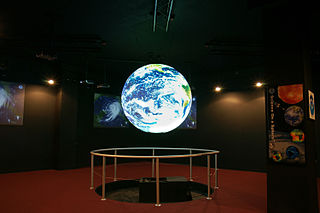
The European Environment Agency (EEA) is the agency of the European Union (EU) which provides independent information on the environment.

The National Oceanic and Atmospheric Administration is an American scientific and regulatory agency within the United States Department of Commerce that forecasts weather, monitors oceanic and atmospheric conditions, charts the seas, conducts deep sea exploration, and manages fishing and protection of marine mammals and endangered species in the U.S. exclusive economic zone.

The United States National Climatic Data Center (NCDC), previously known as the National Weather Records Center (NWRC), in Asheville, North Carolina, was the world's largest active archive of weather data. Starting as a tabulation unit in New Orleans, Louisiana in 1934, the climate records were transferred to Asheville in 1951, becoming named the National Weather Records Center (NWRC). It was later renamed the National Climatic Data Center, with relocation occurring in 1993. In 2015, it was merged with the National Geophysical Data Center (NGDC) and the National Oceanic Data Center (NODC) into the National Centers for Environmental Information (NCEI).

The Climatic Research Unit (CRU) is a component of the University of East Anglia and is one of the leading institutions concerned with the study of natural and anthropogenic climate change.
Thomas R. Karl is the former director of the National Oceanic and Atmospheric Administration’s National Centers for Environmental Information (NCEI). He joined the National Climate Centre in 1980, and when that became the National Climatic Data Center, he continued as a researcher, becoming a Lab Chief, Senior Scientist and ultimately Director of the Center. When it merged with other centers to become NCEI in 2015, he became its first director. He retired on 4 August 2016.
In climatology, the Coupled Model Intercomparison Project (CMIP) is a collaborative framework designed to improve knowledge of climate change. It was organized in 1995 by the Working Group on Coupled Modelling (WGCM) of the World Climate Research Programme (WCRP). It is developed in phases to foster the climate model improvements but also to support national and international assessments of climate change. A related project is the Atmospheric Model Intercomparison Project (AMIP) for global coupled ocean-atmosphere general circulation models (GCMs).

The Global Carbon Project (GCP) is an organisation that seeks to quantify global greenhouse gas emissions and their causes. Established in 2001, its projects include global budgets for three dominant greenhouse gases — carbon dioxide, methane, and nitrous oxide — and complementary efforts in urban, regional, cumulative, and negative emissions.

DBpedia is a project aiming to extract structured content from the information created in the Wikipedia project. This structured information is made available on the World Wide Web. DBpedia allows users to semantically query relationships and properties of Wikipedia resources, including links to other related datasets.

Science On a Sphere (SOS) is a spherical projection system created by the United States National Oceanic and Atmospheric Administration (NOAA). It presents high-resolution video on a suspended globe rather than a flat screen, with the aim of better representing global phenomena. Animated images of atmospheric storms, climate change, and ocean temperature can be shown on the sphere to explain these complex environmental processes. SOS systems are most frequently installed in science museums, universities, zoos, and research institutions, although new and novel uses for these systems in a variety of presentation spaces and contexts are starting to emerge.
Open data in Canada describes the capacity for the Canadian Federal Government and other levels of government in Canada to provide online access to data collected and created by governments in a standards-compliant Web 2.0 way. Open data requires that machine-readable should be made openly available, simple to access, and convenient to reuse. As of 2016, Canada was ranked 2nd in the world for publishing open data by the World Wide Web Foundation's Open Data Barometer.

Species distribution modelling (SDM), also known as environmental(or ecological) niche modelling (ENM), habitat modelling, predictive habitat distribution modelling, and range mapping uses computer algorithms to predict the distribution of a species across geographic space and time using environmental data. The environmental data are most often climate data, but can include other variables such as soil type, water depth, and land cover. SDMs are used in several research areas in conservation biology, ecology and evolution. These models can be used to understand how environmental conditions influence the occurrence or abundance of a species, and for predictive purposes. Predictions from an SDM may be of a species’ future distribution under climate change, a species’ past distribution in order to assess evolutionary relationships, or the potential future distribution of an invasive species. Predictions of current and/or future habitat suitability can be useful for management applications.

The European Climate Assessment and Dataset (ECA&D) is a database of daily meteorological station observations across Europe and is gradually being extended to countries in the Middle East and North Africa. ECA&D has attained the status of Regional Climate Centre for high-resolution observation data in World Meteorological Organization Region VI.
The Atmospheric Circulation Reconstructions over the Earth, ACRE, is an international science project, began in 2008, that recovers historical weather observations to reconstruct past global and local weather patterns and so support meteorological reanalysis. The project aims to collect weather data from the past 250 years by linking international meteorological organisations to support data recovery projects and the imaging and digitisation of historical meteorological observations made at, for example, inland stations, lighthouses, or by ships at sea or in ports. The project aims to create historical datasets that are spatially and temporally complete, so as to be of value at a local, or regional level, as well as on a global scale. ACRE aims to recover millions of historic weather observations. This data will be deposited into two databases,
The National Centers for Environmental Information (NCEI), an agency of the United States government, manages one of the world's largest archives of atmospheric, coastal, geophysical, and oceanic data, containing information that ranges from the surface of the sun to Earth's core, and from ancient tree ring and ice core records to near-real-time satellite images.
The Open Energy Modelling Initiative (openmod) is a grassroots community of energy system modellers from universities and research institutes across Europe and elsewhere. The initiative promotes the use of open-source software and open data in energy system modelling for research and policy advice. The Open Energy Modelling Initiative documents a variety of open-source energy models and addresses practical and conceptual issues regarding their development and application. The initiative runs an email list, an internet forum, and a wiki and hosts occasional academic workshops. A statement of aims is available.
Open energy system database projects employ open data methods to collect, clean, and republish energy-related datasets for open use. The resulting information is then available, given a suitable open license, for statistical analysis and for building numerical energy system models, including open energy system models. Permissive licenses like Creative Commons CC0 and CC BY are preferred, but some projects will house data made public under market transparency regulations and carrying unqualified copyright.

The Tempestry Project is a collaborative fiber arts project that presents global warming data in visual form through knitted or crocheted artwork. The project is part of a larger "data art" movement and the developing field of climate change art, which seeks to exploit the human tendency to value personal experience over data by creating accessible experiential representations of the data.

Climate change art is art inspired by climate change and global warming, generally intended to overcome humans' hardwired tendency to value personal experience over data and to disengage from data-based representations by making the data "vivid and accessible". The intention is to "make an emotional connection...through the power of art".
COVID-19 datasets are public databases for sharing case data and medical information related to the COVID-19 pandemic.










